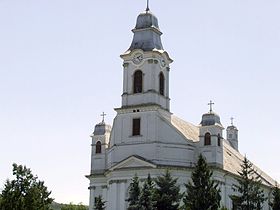Armenians of Romania
This article has multiple issues. Please help improve it or discuss these issues on the talk page. (Learn how and when to remove these template messages)
|
| Total population | |
|---|---|
| 1,361 (2011 census); 10,000 (estimate) | |
| Regions with significant populations | |
| Transylvania, Wallachia | |
| Languages | |
| Armenian, Romanian | |
| Related ethnic groups | |
| Armenian diaspora |
| Part of a series on |
| Armenians |
|---|
 |
| Armenian culture |
|
By country or region |
Armenian diaspora Russia |
| Subgroups |
| Religion |
| Languages and dialects |
|
| Persecution |
|
History
Danubian Principalities
The earliest traces of Armenians in what was later
Armenian expatriates were awarded
In
Citizenship was bestowed on the community only with the decision taken by the international protectorate over the two countries (instituted after the
Transylvania

Armenians were present from early on in
Despite their increasing autonomy, the townspeople's adherence to the
Most Armenians from Transylvania were magyarized in the last half of the 19th century.
Romania
After the
Following
In 1940 about 40,000 Armenians lived in Romania. Under
In the 1990s, after the
Churches and monasteries
-
Armenian Church in Bucharest
-
Armenian Catholic Holy Trinity Cathedral in Gherla
-
Armenian Holy Cross Church in Suceava
Notable Romanians of Armenian descent
Romanians of Armenian descent have been very active in Romanian political, cultural, academic and social life. Most worthy of mention would be Vazgen I, Catholicos of Armenia, and Iacob Zadig, a general in the Romanian Army during World War I.
-
Vasile G. Morțun - journalist, politician, and art collector
-
Virgil Madgearu, politician, prominent member and main theorist of the Peasants' Party
See also
- Armenian diaspora in Europe
- Armenian-Romanian relations
- Armenians in Moldova
- Gherla
- List of Romanians of Armenian descent
References
- ISBN 0-520-01805-2.
- Armenians in Romania at the Central European University site (retrieved on 28 November 2005)
- (in Romanian) Armenii ("The Armenians"), on Divers online bulletin of ethnic minorities in Romania (retrieved on 28 November 2005)
- Neagu Djuvara, Între Orient și Occident. Țările române la începutul epocii moderne ("Between Orient and Occident. The Romanian lands from at the beginning of the modern era"), Humanitas, Bucharest, 1995, p. 178
- Constantin C. Giurescu, Istoria Bucureștilor. Din cele mai vechi timpuri pînă în zilele noastre ("History of Bucharest. From the earliest times to our day"), Ed. Pentru Literatură, Bucharest, 1966, p. 98, 270-271
- Nicolae Iorga, Choses d’art arméniennes en Roumanie ("Artworks of Armenians in Romania"), 1935
- Kornél, Nagy (2011). "The Catholicization of Transylvanian Armenians (1685-1715): Integrative or Disintegrative Model?". Integrating Minorities: Traditional Communities and Modernization. Cluj-Napoca: Editura ISPMN. pp. 33–56. ISBN 9786069274491.
External links
- (in Romanian) Ararat online
- List of Armenian Churches in Romania
- (in Romanian) Marius Vasileanu, "Biserica Armeană" ("The Armenian Church"), in Adevărul
















